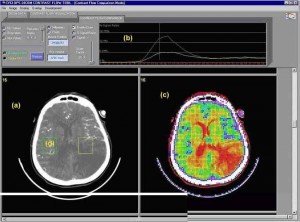Introduction
Ischaemic stroke is a very common disease that affects blood vessels in the brain causing cerebral tissue damage. Despite several studies on this subject, the early detection of acute ischaemic stroke is difficult as well its treatment. In this work we present some features and initial results of our research which includes not only a new image acquisition protocol, but also a software tool in order to help physicians improve the accuracy of the therapy.
Problem Description
The term ischaemic stroke refers to sudden endangering of the cerebral functions due to a variety of histopathological alterations involving one or more blood vessels. About 80% of the stroke cases are caused by insufficient blood flow (ischaemic stroke). When the blood flow, in a specific cerebral region, falls bellow of 20ml/100g/min, the cerebral electric activity fails and the symptoms appear. If the blood flow keeps falling to 10ml/100g/min, an ischaemic central area arises resulting in the death of the neurons. Around this central there is a region where the blood flow is reduced, however the perfusion is kept by the collateral circulation. These neurons that don’t function but are alive form the penumbra zone, which has no metabolic activity but may be recovered with medical intervention. Once the ischaemic stroke is identified, the therapy can be performed with the utilization of thrombolytics as an attempt to restore the blood flow in the obstructed region. This type of therapy has the purpose to restore the flow as soon as possible in order to limit the neuronal losses.
The specification of a methodology to perform CT examination joined to a software tool that can help physicians to detect early ischaemic stroke and to identify penumbra zones, will benefit the therapy, since several works point towards better results when the thrombolytic therapy is started within three hours after the first symptomssses in the penumbra area.
Objectives
Development of a radiological protocol and a decision support software to help physicians to decide whether the thrombolytics therapy is suitable or not. Specific objectives are as follows:
- Calculation and graphical representation of the blood flow in the brain based on dynamic CT;
- Using computer analysis for early detection of ischaemic stroke;
- Identifying low blood flow regions (penumbra zone) that could be potentially recoverable;
- Measuring the size of the penumbra zone; – Validating the software prototype with help of physicians;
Results
The results obtained so far are promising since the tests for the 4 patients are consistent. At this moment there is a first version of the software and a large-scale study has been planed. The software’s graphical user interface (GUI) is showed on figure 1. The image was obtained from a patient suspected to have ischaemic stroke isquêmico with a) tomography slice nr. 15, b) signal variation curve related to the VOR (green) compared to the other volume chosen (yellow), c) perfusion map on slice nr. 16 showing higher perfusion areas than the VOR mean turning to purple and lower perfusion areas turning to red, and d) VOR limits (green)
